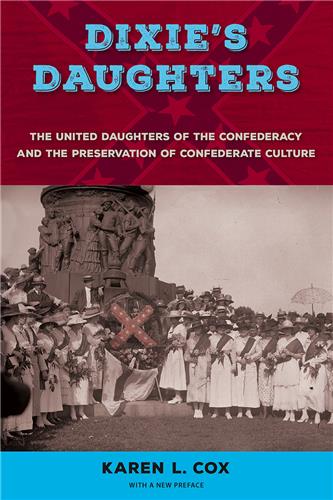Dixie's Daughters, with a New Preface
The United Daughters of the Confederacy and the Preservation of Confederate Culture
Karen L. Cox
Paper: $24.95
Wall Street Journal’s Five Best Books on the Confederates’ Lost Cause
Southern Association for Women Historians Julia Cherry Spruill Prize
“The definitive history of the UDC.”—Daily Beast
“Highlights the central role the United Daughters of the Confederacy (UDC) played in creating and sustaining the myth of the Lost Cause in early-twentieth-century southern culture.”—Choice
“This younger generation of white southern women was committed to the public vindication of their parent’s wartime experiences. They did this through a massive program of monument building, but as Cox astutely argues, they were even more effective in promoting a pro-Confederate interpretation of the Civil War.”—American Historical Review
“Demonstrates the UDC’s many kinds of influence on generations of white southerners.”—Journal of American History
“Cox . . . argues convincingly that it was women who, by the turn of the twentieth century, were the true keepers of the Confederate flame. . . . Her book is a valuable contribution to the historiography of the Lost Cause.”—Journal of Southern History
“Provides a much-needed institutional history of the UDC at the height of its influence. . . . Emphasizes that women, not men, shaped the South’s memory of the war and thereby perpetuated a ‘Confederate culture’ that celebrated mainly the veterans but also the women of the wartime generation and that rested on a coherent narrative of the South’s history.”—Southern Cultures
“Adds a new dimension to the growing scholarship on the creation of historical memory.”—H-NET Reviews
Even without the right to vote, members of the United Daughters of the Confederacy proved to have enormous social and political influence throughout the South—all in the name of preserving Confederate culture. Karen Cox traces the history of the UDC, an organization founded in 1894 to vindicate the Confederate generation and honor the Lost Cause. In this edition, with a new preface, Cox acknowledges the deadly riots in Charlottesville, Virginia, showing why myths surrounding the Confederacy continue to endure.
The Daughters, as UDC members were popularly known, were daughters of the Confederate generation. While southern women had long been leaders in efforts to memorialize the Confederacy, UDC members made the Lost Cause a movement about vindication as well as memorialization. They erected monuments, monitored history for "truthfulness," and sought to educate coming generations of white southerners about an idyllic past and a just cause—states' rights. Soldiers' and widows' homes, perpetuation of the mythology of the antebellum South, and pro-southern textbooks in the region's white public schools were all integral to their mission of creating the New South in the image of the Old. UDC members aspired to transform military defeat into a political and cultural victory, in which states' rights and white supremacy remained intact. To the extent they were successful, the Daughters helped to preserve and perpetuate an agenda for the New South that included maintaining the social status quo.
Placing the organization's activities in the context of the postwar and Progressive-Era South, Cox describes in detail the UDC's origins and early development, its efforts to collect and preserve manuscripts and artifacts and to build monuments, and its later role in the peace movement and World War I. This remarkable history of the organization presents a portrait of two generations of southern women whose efforts helped shape the social and political culture of the New South. It also offers a new historical perspective on the subject of Confederate memory and the role southern women played in its development.
Karen L. Cox is professor of history at the University of North Carolina at Charlotte. She is the author of Goat Castle: A True Story of Murder, Race, and the Gothic South and Dreaming of Dixie: How the South Was Created in American Popular Culture, and is the editor of Destination Dixie: Tourism and Southern History. A volume in the series New Perspectives on the History of the South, edited by John David Smith
- Sample Chapter(s):
- Table of Contents
- Excerpt
There are currently no reviews available












